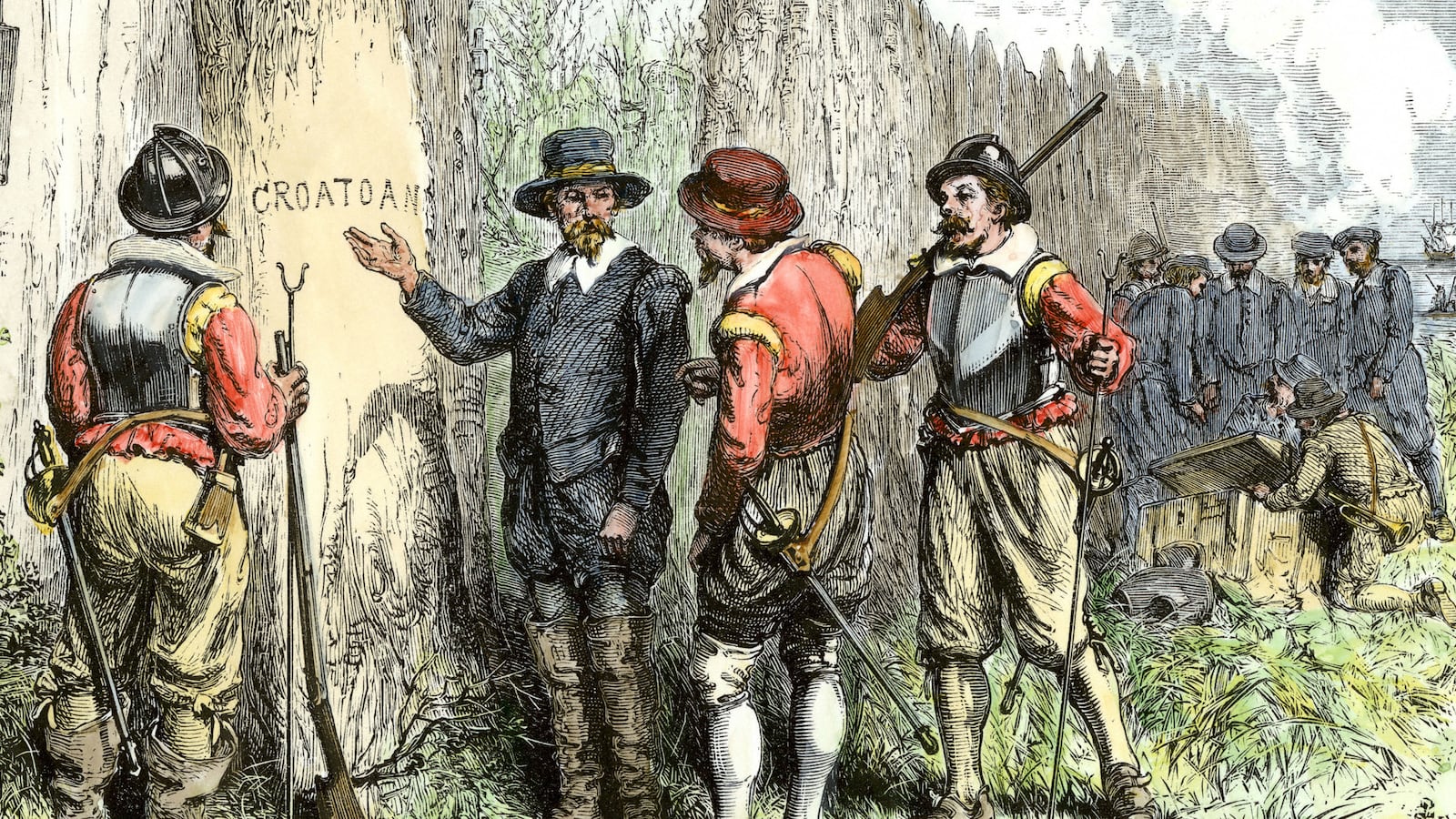It’s one of the greatest mysteries in American history: An entire colony of people vanished—seemingly into thin air—never to be seen or heard from again.
For more than 400 years, mystery has shrouded what happened to the 115 English civilians who settled on Roanoke Island, off present-day North Carolina, in 1587.
Sometime between their arrival and 1590, they abandoned their colony.
It happened slowly and without force, which, for the most part, ruled out any suspicion of attack from groups of pissed off Native Americans.
The homes had been neatly and cleanly deconstructed; the only clue left was the words “Croatoan” (a nearby island) carved into a fencepost and “CRO” carved into a nearby tree.
According to historical accounts, it was suspected that the chief of the Powhatan tribe had personally conducted the slaughter of the colonists—including Virginia Dare, the first child born in the New World to English parents. But there’s been no further evidence to solidify the claim.
One contemporary theory is that the clan abandoned the colony and assimilated themselves within the Native American culture.
The carvings have led many researchers to survey Croatoan (modern-day Hatteras Island), some 50 miles south, where a group of Native Americans had settled.
Then, you know, aliens.
But a team of archeologists excavating at an undisclosed area near Merry Hill, North Carolina, believes they may have discovered vital clues into what exactly happened in a chapter of history that has remained completely blank.
Nicholas M. Luccketti, who runs the James River Institute for Archeology, told The New York Times ahead of a big announcement on Tuesday in Chapel Hill, North Carolina, “We have evidence from this site that strongly indicates that there were Roanoke colonists here.”
Luccketti was referring, it emerged later, to the discovery of ceramics.
“The relatively large amount of Surrey-Hampshire Border ware, as well as shards of North Devon plain baluster jar, which were provisioning jars for sea voyages, leads us to postulate that these finds are the result of Roanoke colonist activity at the site and are not related to later English settlement in the area,” the team stated in a press release sent to The Daily Beast.
“This evidence is more likely the result of the 1587 colony’s stated plan to relocate from Roanoke Island rather than possible brief visits in previous years,” the team said.
Since 2012, Luccketti and his team have been working with First Colony Foundation in surveying an area of land that had previously been hidden on a 16th-century map. Using X-ray spectroscopy, the British Museum discovered a four-pointed star marking an area 50 miles inland from Roanoke that possibly represented a fort.
After all, the colonists never intended to make Roanoke their final settlement.
So archeologists began to dig. And heaps of relics began to pile up.
There’s been loads of Native American artifacts, which is to be expected in the area, but what really caught the attention of researchers were a particular style of ceramics: Surrey-Hampshire Border ware, which ceased being imported when the Virginia Company stopped establishing settlements in the early 1600s.
There was also food-storage jars, hide stretchers, buckles, and pieces of an early gun, which helped confirm that at least a small amount of settlers—fewer than a dozen—had been there at one point in time.
“What’s been discovered is that some part of the Lost Colony, when they left Roanoke Island [in Dare County], came to Bertie County,” Brent Lane, who serves on the Board of Directors of the First Colony Foundation, told the Roanoke-Chowan News-Herald in June.
“We don’t yet know how many, and we don’t know for how long, but the evidence we have now is that a small group of ‘lost colonists’ who, when they stated their purpose was to move from Roanoke Island 50 miles into the mainland, some of them came to Bertie County.”
Similar findings have surfaced on Hatteras Island, which further propels the assimilation theory, even if groups of colonists did eventually split up.
The theory posits that the colonists abandoned Roanoke to seek help from the Croatans while they waited for supplies from England that had been delayed by the Anglo-Spanish War, and eventually settled with the tribe for good.
“We already knew some of that from historic sources, including some of the reports from the Jamestown (VA) colony themselves from 400 years ago,” said Lane. “There were reports from the Indians in the area that there were survivors of Sir Walter Raleigh’s Roanoke colony living in the Chowan River area.”
Their archeological findings helped Lane and his colleagues confirm what the Native Americans had said—that “the survivors of the Roanoke colony had in many ways become members of the Indian tribe, and had become members of the local Indian community themselves,” Lane said.
But the Croatan on Hatteras Island suffered greatly from waves of infectious diseases like smallpox, and were almost wiped out by the early 17th century.
A stone discovered in 1937 purports to tell the tale that the 115 colonists suffered attacks by local tribes and were reduced to 24 survivors, a figure which shrank to seven when the natives turned against them.
Many attribute the formation of the Lumbee tribe to English settlers and the Croatan, including oral history by current tribes.
In very early accounts the Lumbee were described as being fluent in English, having European features, and branding the surnames of many settlers at the Lost Colony of Roanoke Island.
They are presumed to be direct descendants of the Croatan and Roanoke survivors, who had moved inland and settled along the banks of Lumber.
Luccketti believes the recent findings, specifically the ceramics, likely shows that a number of colonists separated from the others in an attempt to resettle on the Albemarle Sound, located in modern-day Bertie County, where the team is excavating.
And so, tantalizingly, the search for answers continues.






